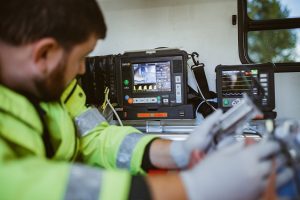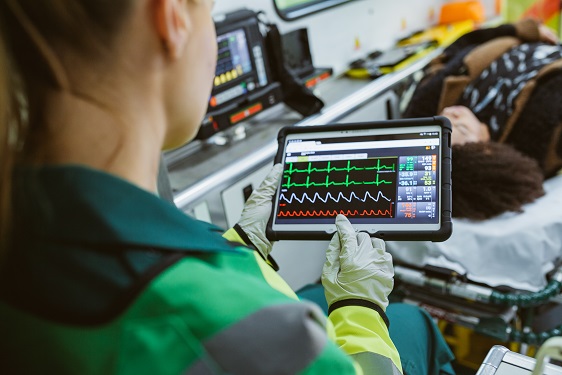As the NHS adopts technology at an increased speed, it must ensure all stages of care are digitised and integrated, including the pre-hospital setting. The launch of a new digitally enabled monitor/defibrillator by Remote Diagnostic Technologies (RDT) will help services achieve many of the ambitions set out for the urgent care and emergency services by 2020.
Graham Murphy, CEO of RDT, elaborates on the clinical capabilities of the Tempus ALS and its promise for the digital continuum of care.
NHS England’s Five Year Forward View (5YFV) [1] and The Association of Ambulance Chief Executives’ (AACE) vision for the ambulance service in 2020 [2] work in tandem and are fundamentally underpinned by technology, encouraging new models of care to be delivered closer to home and in the community. These principles are reflected in the Urgent and Emergency Care Review (U&ECR)3 which calls for services to be more connected and integrated, with the ambulance playing a pivotal role as a connectivity hub [3].
One of the greatest current challenges in pre-hospital settings are delayed and lengthy patient handover times, potentially leading to poorer patient outcomes. From 2015 to 2016, 500,000 ambulance hours were lost due to delayed transfer of care at hospitals, and only 58% of transfers met the 15-minute expectation [4]. A&E admissions show no sign of slowing, with an average of 18.8 thousand ambulance calls per day requiring a face-to-face response [5].
It is crucial that new technologies entering the market span the interface between pre-hospital and secondary care and enable the collection and sharing of patient data for a smoother handover. Even before reaching the hospital, technology can support the right treatment and delivery decisions, both on scene and in the ambulance.
Empowering paramedics at the scene
Before making a decision for onward care, a paramedic must first attend the patient at hand. Arriving at the scene with heavy equipment is physically demanding. Once on-scene, paramedics are often faced with complex cases and a number of human factors and other distractions, such as bystanders, limited resources and paper notes [6]; this can put pressure on the paramedic’s cognitive bandwidth, limiting their ability to completely focus on their patient and make necessary difficult decisions. Equipment suppliers must aid optimal treatment in the challenging pre-hospital setting.
Pre-hospital specialist Remote Diagnostic Technologies (RDT) is focusing on reducing unnecessary strain on the paramedic through innovative equipment, enabling paramedics to focus on their patient, not technology. RDT has recently launched its new monitor/defibrillator, Tempus ALS (Advanced Life Support). Comprising a 3kg vital signs monitor and 2kg defibrillator, it replaces the 8-15kg monitor commonly carried by paramedics and allows for standard deployment across all vehicles types – from bikes to helicopters. The defibrillator is so small that it can fit in a paramedic’s equipment bag; the paramedic only carries a 3kg monitor.
As a defibrillator is mandatory, but used infrequently in call-outs, the Tempus ALS incorporates a unique dual screen capability, allowing the monitor and defibrillator to perform all functions independently but to automatically pair when together. Therefore, each user is provided with only the data they need to get the job done, allowing paramedics to focus on patient care.
Digitising pre-hospital care for a smoother patient handover
The London Ambulance Service reports that up to 50% of 999 ambulance calls can be managed at the scene [7], avoiding unnecessary journeys to hospital. Using the Tempus ALS, paramedics can transmit patient vital signs data and voice, image and video information in real-time for support advice and recommended action. This allows for feedback which can enhance decision making at the scene, potentially avoiding unnecessary delivery to A&E or enabling bypass of A&E to more specialised care.
The Tempus ALS is underpinned by the same platform that powers the Tempus Pro, the vital signs monitor used by the UK Ministry of Defence and other NATO countries. During a patient interaction, the Tempus ALS automatically captures key clinical data and creates a customisable Summary Record of Care (SRoC), removing the need for paramedics to retrospectively log handwritten, hard-to-read notes. The SRoC can then be automatically integrated into an ePCR, improving accuracy and efficiency.
Furthermore, sharing the SRoC from the scene to the ambulance to the hospital notifies the emergency room (ER) or Cath Lab, for example, of a patient in transit. In this way, the record of care is shared with the secondary care team, supporting better decision making and preparedness, contributing to reduced handover times.

Corsium Suite
Collecting accurate data in pre-hospital settings is very challenging. In response, RDT has developed Corsium Suite, a highly secure digital ecosystem that sits around the Tempus technology. A first in its class, Corsium uses patented communications and data management technology to ensure that data captured on Tempus devices can be reliably and securely delivered in real time or post event to relevant stakeholders and upstream ePCR systems. This can be extended to other relevant care providers for use in secondary care, community paramedicine, primary care and for big data research.
With Corsium, Ambulance Trusts can securely access tailored online dashboards on any device via a web browser. Users can view all previous and ongoing cases where Tempus technology is being used, with live streaming of 12 lead ECG data and all vital signs. The dashboard can allow live feedback to the paramedic on a range of clinical decisions and directing ambulances to the most suitable, or least busy hospital.
Data collected from patient interaction at the scene can be classed as ‘secondary uses’ datasets [8], data which can be used for many purposes, other than providing direct care to individuals. With Corsium, NHS England and Ambulance Trusts will be able to mine accurate data like never before from the pre-hospital setting, for example, easily obtaining full Code review data for all cases; currently services typically get less than 10% of this data. This will improve Clinical Governance, health research and population risk management, helping CCGs and NHS England to commission the best quality care.
For a truly digital hospital, a holistic approach must be taken so that patients can be monitored and logged from the moment a paramedic or first responder interacts, until the best onward care pathway is chosen. A connectivity hub underpinned by the Tempus ALS and Corsium Suite, has the potential to change the way pre-hospital care is delivered, to ensure a smart, robust response is achieved.
For more information on RDT, the Tempus ALS or Corsium suite, please visit http://www.rdtltd.com/
References
1. Next steps on the NHS Five Year Forward View, NHS England, March 2017
2. Association of Ambulance Chief Executives, A Vision for the ambulance service: ‘2020 and beyond’ and the steps to its realisation, Sept 2015
3. NHS England, Transforming urgent and emergency care services in England, Clinical models for ambulance services, Nov 2015
4. NHS England NHS Ambulance Services, National Audit Office, p8, Session 2016-17, 26 January 2017
5. Statistical Note: Ambulance Quality Indicators (AQI), NHS England AQI Statistical Note, p6, 11 May 2017
6. Price R, Bendall JC, Patterson JA, et al. What causes adverse events in prehospital care? A human-factors approach. Emerg Med J, 30:583-588, 2013
7. The London Ambulance Service, 5 Year Strategy, 2014/15 – 2019/20
8. Honeyman M, Dunn P, McKenna H. A digital NHS? An introduction to the digital agenda and plans for implementation. The King’s Fund, p20, 2016





